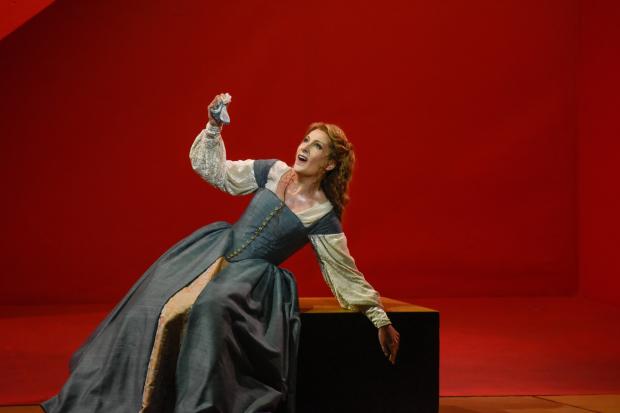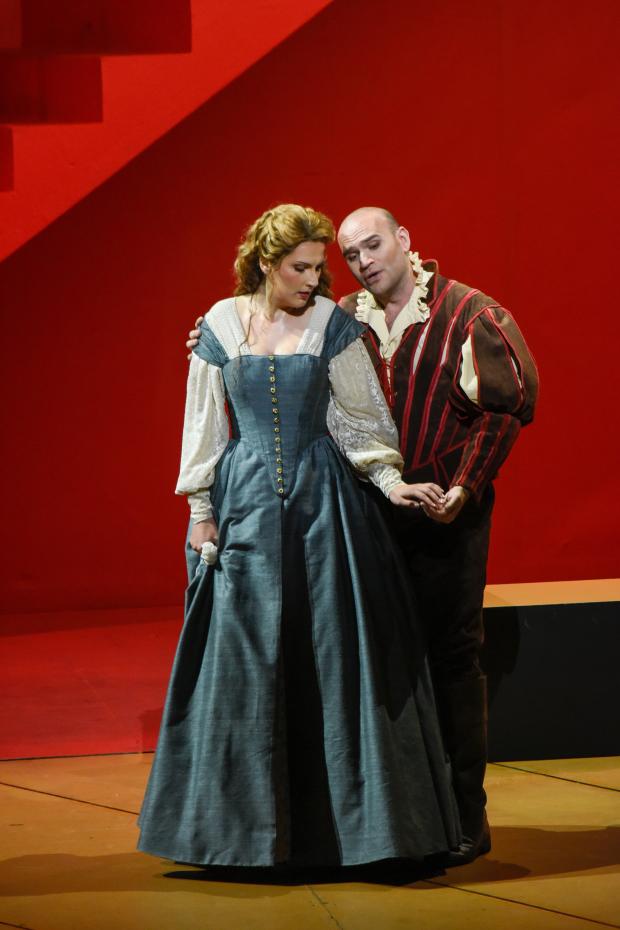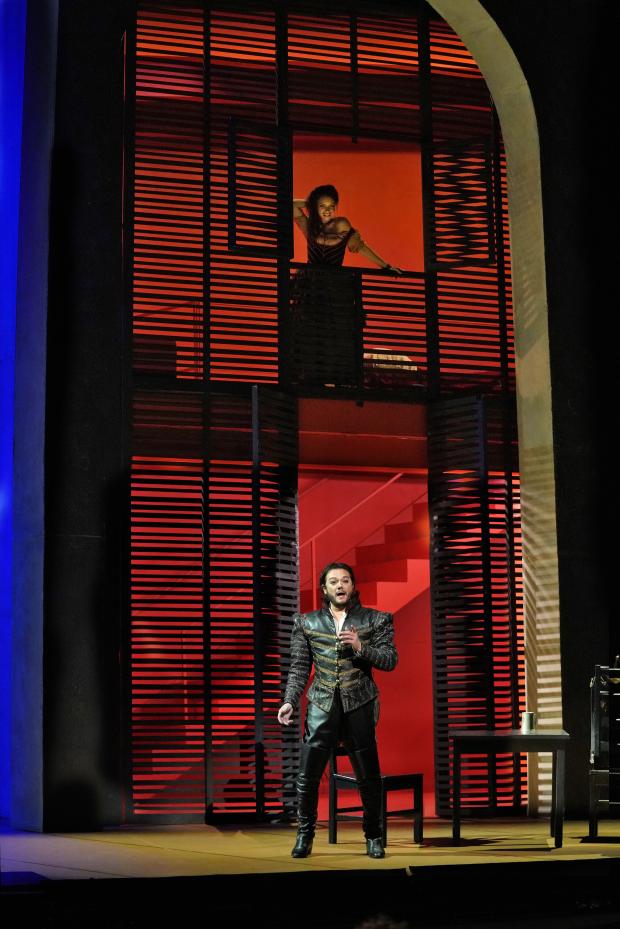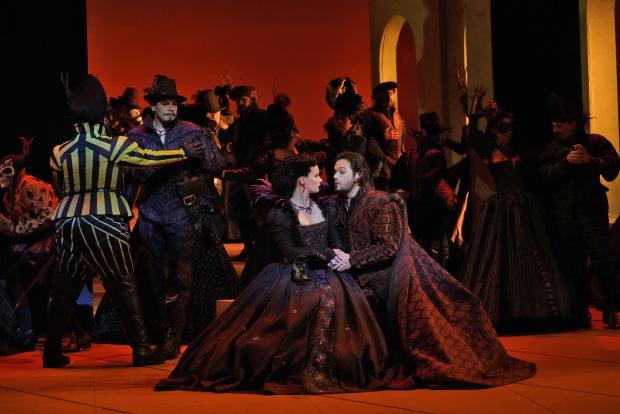Along with William Shakespeare’s Richard III, Giuseppe Verdi’s Rigoletto are the stage’s most famous disabled characters. Like Victor Hugo’s Quasimodo, they are hunchbacks who share with King Richard, as the Bard wrote, being “rudely stamp'd… deformed, unfinish'd…” and unable to “strut before a wanton ambling nymph.” (Verdi’s 1851 opera, with a libretto by Francesco Maria Piave, is actually based on an 1832 play by Hugo, Le Roi s’amuse, which was banned after a single performance because it criticized royalty.)
Rigoletto is a figure of fun - not only because cruel people take perverse delight in mocking the disabled (like Trump despicably mimicking a NY Times reporter with a disability), but because Rigoletto is also the court jester of the Duke of Mantua. (In LA Opera’s May 27-June 3 performances, Italian baritone Ambrogio Maestri was Rigoletto while from May 12-19 Spanish baritone Juan Jesus Rodriguez played the part. New Jersey tenor Michael Fabiano was the Duke May 27-June 3, while Mexican tenor Arturo Chacon-Cruz had the role May 12-19.)
To paraphrase Samantha Bee, the libertine Duke is a “feckless cock.” Among the countless women he seduces are the married Countess Ceprano (Minnesota soprano Liv Redpath) and the daughter of Count Monterone (L.A. bass baritone Craig Colclough). When the latter openly accuses the Duke of taking advantage of his daughter, Rigoletto, as the court’s clown, mercilessly ridicules Monterone as a no-account count.
But like the embattled Bee, the harlequin faces reprisals for his joking. (Note that Bee’s compassionate point about the Trump regime’s breaking up of immigrant families is largely being overlooked in favor of obsessing over her blue language.) [PLOT SPOILER ALERT!] The count curses Rigoletto, rigging his fate so what happened to Monterone’s daughter also befalls the court jester’s own daughter, Gilda (portrayed by Romanian soprano Adela Zaharia May 27-June 3 and May 12-19 by Louisiana soprano Lisette Oropesa). Both comedians are made to pay a price for their humor - although Rigoletto (who, BTW, is derived from an actual historical figure whom Hugo called Triboulet) lived centuries ago in Northern Italy during the Renaissance, while Bee inhabits a purported democracy with free speech guarantees.
And now, a word from the Ministry of Ranting and Raving:
However, the beleaguered Bee is now finding out that in 2018 America, you have freedom of speech until the precise moment when you publicly practice the thought crime of speaking freely against the high and mighty - and then you find out how free you really are! Will TBS bow to the edict of Count Donald - the thin-skinned insulter-in-chief who used the “P” word and can dish it out without ever apologizing for his cruelty and crudity, but can’t take it - to fire Samantha from her Full Frontal TV show for using the “C” word? Will Bee be deported back to her birthplace of Canada for, among other things, making fun of Trump’s openly expressed incestuous desires for Ivanka (who, lest we forget, is a White House official)? Do we still have a First Amendment in this country? To Bee or not to Bee, that is the question!
Meanwhile, back at the review:
Verdi’s opera opens with melodramatic horns, drums and cymbals, foreshadowing the sturm und drang to come. Verdi’s music, of course, is plush, especially during the lovely, lilting, lush “La donna e mobile,” which seems to repeatedly stop and start over again. A highly animated Matthew Aucoin conducts with panache throughout the almost three hour extravaganza with one intermission.
Rigoletto has exceptionally emotional arias - which were trendsetting for the operatic medium in the mid-19th century - sung in Italian, such as Gilda’s “Caro nome,” warbled warmly by Zaharia as a love-struck virginal young lady enamored of the deceptive Duke. (I couldn’t help but wonder if Rita Hayworth’s most famous sensuous character derived her name from Rigoletto’s daughter for the 1946 film noir classic Gilda?)
The Duke has witty arias, including “Questa o quella” and the more dramatic “Pari siamo”, which expound upon his freewheeling (and double-dealing) philosophy of philandering. (What would the #MeToo and #TImesUp movements make of this callow cad?) Fabiano expertly holds forth in good voice but I have a quibble with his appearance. The Duke is very specifically referred to as “young” and he tries to fob himself off as a “student” to the gullible, beguiled Gilda as part of his cynical seduction campaign. However, Fabiano appears quite bald, which belies the youthfulness his role requires. Opera often casts the best singer for a part based on his/her voice, not his/her physical appearance, so sometimes, for example, very oversized performers play characters described as beautiful, handsome, etc. In this case, a wig could have simply solved the discrepancy between performer and part, which detracted from Coleridge’s willing suspension of disbelief. Opera needs more “truth in advertising.”
Georgia bass Morris Robinson is menacing as the assassin Sparafucile. In the title role as the court jester trapped by fate Maestri has a Zero Mostel-like vibe. (Speaking of comics who suffered for their free expression, Zero was blacklisted during the 1950s for, among other things, impersonating a butterfly at rest at Communist Party functions.). Maestri’s multi-hued harlequin’s outfit is a delight to behold, as are Constance Hoffman’s other period garb, which wonderfully evoke the Renaissance. In other scenes, Rigoletto and Sparafucile wear fedora-like hats, cleverly reminiscent of those other Sopranos - 20th century mobsters. And Hoffman has designed the best commedia dell’arte masks this side of Culver City’s Actors’ Gang.
My favorite scene is the opening, depicting revels at the Ducal “Palace of pleasures.” It’s good to be the Duke and be transported back in time to the Italian Renaissance! The discerning eye will note that designer Michael Yeargan’s sets are partially derived from Giorgio de Chirico’s surrealistic 20th century paintings. (But minus those locomotives about to smash into walls, as this is 16th century Lombardy - before railroads were invented.)
There is only one performance of this stellar Rigoletto left, and I was said to reflect that it marks the end of this season’s LA Opera productions at the Dorothy Chandler. Parting is such sweet sorrow! I guess that until September, to paraphrase the immortal words of Ann-Margret:
“Bye, bye, Verdi
I’m gonna miss you so
Bye, bye, Verdi
Why’d ya have to go…?”
In the meantime, until LA Opera returns in September, we’ll just have to amuse ourselves by watching Samantha Bee sting the rich and powerful on Full Frontal!
Rigoletto will be performed Sunday, June 3 at 2:00 p.m. at L.A. Opera at the Dorothy Chandler Pavilion, 135 N. Grand Ave., Los Angeles, CA 90012. See: https://www.laopera.org/season/1718-Season/rigoletto/.
And opera fans should not despair, because LA Opera is also
presenting a “scare pair” - two performances of Usher House and The Canterville Ghost as part of the LA Opera Off Grand series on Friday, June 22, 2018, at 7:30 p.m. and Sunday, June 24, 2018, at 2:00 p.m. at The Broad Stage, 1310 11th Street, Santa Monica, CA 90401. For info and tickets see: LAOpera.org/Usher.
L.A.-based reviewer/historian Ed Rampell is co-presenting “Marx @ 200: The Marxist Movie Series” (https://www.gofundme.com/marx-200-the-marxist-movie-serie). The third edition of “The Hawaii Movie and Television Book” co-authored by Rampell is now available at: https://mutualpublishing.com/product/the-hawaii-movie-and-television-book/ .




